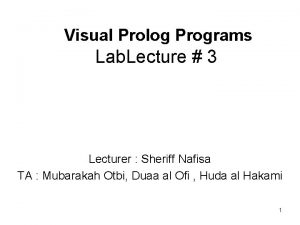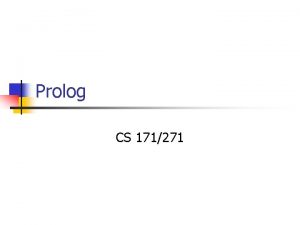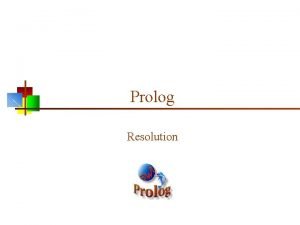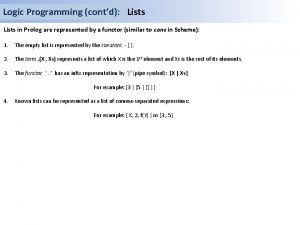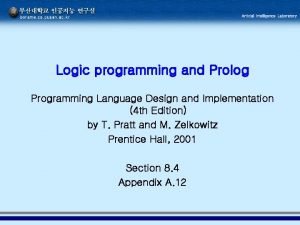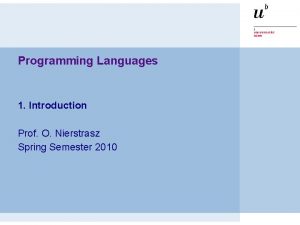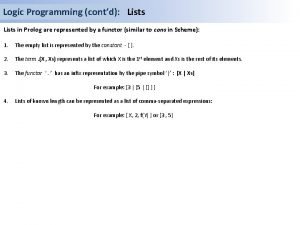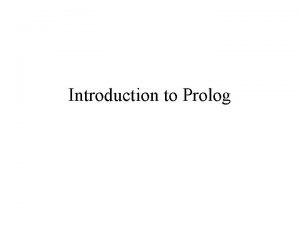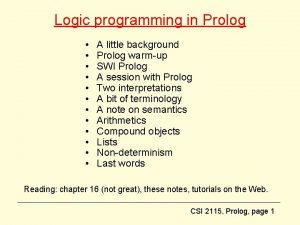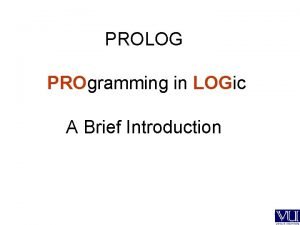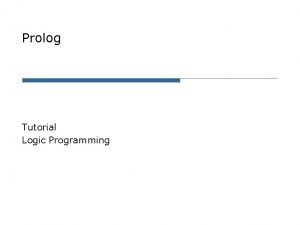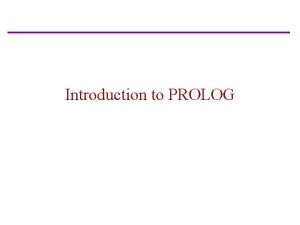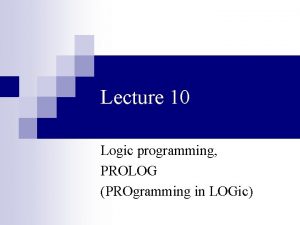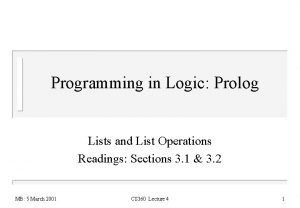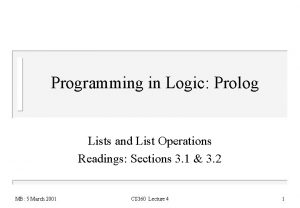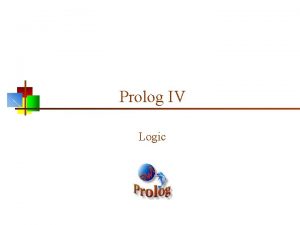Logic Programming contd Lists in Prolog are represented










![Logic Programming (cont’d): Lists Example 5: Merging sorted lists merge([X|Xs], [Y|Ys], [X|Zs]) : - Logic Programming (cont’d): Lists Example 5: Merging sorted lists merge([X|Xs], [Y|Ys], [X|Zs]) : -](https://slidetodoc.com/presentation_image/69cb4647d9793013b16e011d7f268d3c/image-11.jpg)






![solve(member(X, [a, b, c])) {Goal_1 = member(X, [a, b, c])} 1 solve(member(X, [a, b, solve(member(X, [a, b, c])) {Goal_1 = member(X, [a, b, c])} 1 solve(member(X, [a, b,](https://slidetodoc.com/presentation_image/69cb4647d9793013b16e011d7f268d3c/image-18.jpg)
- Slides: 18

Logic Programming (cont’d): Lists in Prolog are represented by a functor (similar to cons in Scheme): 1. The empty list is represented by the constant - [ ]. 2. The term. (X , Xs) represents a list of which X is the 1 st element and Xs is the rest of its elements. 3. The functor ‘. ’ has an infix representation by ‘|’ (pipe symbol): [X | Xs] For example: [3 | [5 | [] ] ] 4. Known lists can be represented as a list of comma-separated expressions: For example: [ X, 2, f(Y) ] or [3 , 5]

Logic Programming (cont’d): Lists Example 1: Implementing a Context Free Grammar in PROLOG: S NP VP Det N V NP | V a | the woman | man saw Q: What language does this CFG represent? ? - s([a, woman, saw, a, man]). true ? -s(X). X = [the, woman, saw, the, woman]; X = [the, woman, saw, the, man]; X = [the, woman, saw, a, woman]; X = [the, woman, saw, a, man]; X = [the, woman, saw] … ? -s([the, man|X]). X = [saw, the, woman]; X = [saw, the, man]; X = [saw, a, woman] … Representation in PROLOG: s(Z) : - np(X), vp(Y), append(X, Y, Z). np(Z): - det(X), n(Y), append(X, Y, Z). vp(Z): - v(X), np(Y), append(X, Y, Z). vp(Z): - v(Z). det([the]). det([a]). n([woman]). n([man]). v([saw]).

Logic Programming (cont’d): Lists Example 1: Implementing a Context Free Grammar in PROLOG: S NP Adj VP Det N V NP VP Det N | Det Adj N vicious | marvelous V NP | V a | the woman | man shoots Q: How would we implement the modifications above? Representation in PROLOG: s(Z) : - np(X), vp(Y), append(X, Y, Z). np(Z): - det(X), n(Y), append(X, Y, Z). np(Z): - det(X), adj(W), n(Y), append([X, W, Y], Z]). vp(Z): - v(X), np(Y), append(X, Y, Z). vp(Z): - v(Z). adj([vicious]). adj([marvelous]). det([the]). det([a]). vp(Z): - v(X), np(Y), append(X, Y, Z). vp(Z): - v(Z). n([woman]). n([man]). det([the]). det([a]). v([shoots]). n([woman]). n([man]). v([shoots]).

Logic Programming (cont’d): Lists Example 2: Determining the order of specific times o In logic programming, symbols have no values: ‘ 2’ and ‘ 9’ are names and not numbers. o We cannot use the < relation to compare the order of numbers (it is infinite!). o A finite relation can be represented. We would like to implement an order relation between pairs of the form (hour, weekday). % Signature: weekday_list(List)/1 % Purpose: Holds the ordered list of week days. weekday_list([d('Sun'), d('Mon'), d('Tue'), d('Wed'), d('Thu'), d('Fri'), d('Sat')]). % Signature: hour_list(List)/1 % Purpose: Holds the ordered list of days hours. hour_list([h(0), h(1), h(2), h(3), h(4), h(5), h(6), h(7), h(8), h(9), h(10), h(11), h(12), h(13), h(14), h(15), h(16), h(17), h(18), h(19), h(20), h(21), h(22), h(23)]). % Signature: precedes(A, B, List)/1 % Purpose: The element A precedes the element B in the List. precedes(A, B, List) : - append([_, [A], _, [B], _], List).

Logic Programming (cont’d): Lists Example 2: Determining the order of specific times weekday_list([d('Sun'), d('Mon'), d('Tue'), d('Wed'), d('Thu'), d('Fri'), d('Sat')]). hour_list([h(0), h(1), h(2), h(3), h(4), h(5), h(6), h(7), h(8), h(9), h(10), h(11), h(12), h(13), h(14), h(15), h(16), h(17), h(18), h(19), h(20), h(21), h(22), h(23)]). A predicate to identify weekdays: % Signature: is_weekday(Day)/1 % Purpose: Day is a day of the week. is_weekday(d(D)) : - weekday_list(Weekday_list), member(d(D), Weekday_list). An order relation between weekdays: % Signature: weekday_order(Day 1, Day 2)/2 % Purpose: weekday Day 1 precedes the weekday Day 2 % in some weekday_order(d(D 1), d(D 2)) : - is_weekday(d(D 1)), is_weekday(d(D 2)), weekday_list(Weekday_list), precedes(d(D 1), d(D 2), Weekday_list).

Logic Programming (cont’d): Lists Example 2: Determining the order of specific times weekday_list([d('Sun'), d('Mon'), d('Tue'), d('Wed'), d('Thu'), d('Fri'), d('Sat')]). hour_list([h(0), h(1), h(2), h(3), h(4), h(5), h(6), h(7), h(8), h(9), h(10), h(11), h(12), h(13), h(14), h(15), h(16), h(17), h(18), h(19), h(20), h(21), h(22), h(23)]). A predicate to identify hours: % Signature: is_hour(Hour)/1 % Purpose: Hour is an hour of the day. is_hour(h(H)) : - hour_list(Hour_list), member(h(H), Hour_list). An order relation between hours: % Signature: hour_order(H 1, H 2)/2 % Purpose: hour H 1 precedes the hour H 2 in some day. hour_order(h(H 1), h(H 2)) : - is_hour(h(H 1)), is_hour(h(H 2)), hour_list(Hour_list), precedes(h(H 1), h(H 2), Hour_list).

Logic Programming (cont’d): Lists Example 2: Determining the order of specific times A predicate to identify times: % Signature: is_time(T)/1 % Purpose: T is an hour of the week. is_time(h(H), d(D))) : - is_hour(h(H)), is_weekday(d(D)). An order relation between times: % Signature: time_order(T 1, T 2)/1 % Purpose: The time T 1 precedes the time T 2 in the week. time_order(time(h(H 1), d(D 1)), time(h(H 2), d(D 2))) : - is_time(h(H 1), d(D 1))), is_time(h(H 2), d(D 2))), weekday_order(d(D 1), d(D 2)). time_order(time(h(H 1), d(D)), time(h(H 2), d(D))) : - is_time(h(H 1), d(D))), is_time(h(H 2), d(D))), hour_order(h(H 1), h(H 2)). ? - is_time(h(1), d('Sun'))). true ? - time_order(time(h(5), d('Mon')), time(h(1), d('Tue'))). true

Logic Programming (cont’d): Lists Example 3: Deleting all occurrences of an element from a list. % Signature: delete(List, X, Has. No. Xs)/3 % Purpose: The list Has. No. Xs is the result of removing % all occurrences of X from the list List. % Example: ? - delete([2, 3, 2, 4, 5, 2, 4], 2, X). % X = [3, 4, 5, 4] delete([], _, []). delete([X|Xs], Z, [X|Ys]) : - X = Z, delete(Xs, Z, Ys). delete([X|Xs], X, Ys) : - delete(Xs, X, Ys).

Logic Programming (cont’d): Lists Example 5: Deleting one occurrence of an element from a list. % Signature: select(X, Has. Xs, One. Less. Xs)/3 % Purpose: The list One. Less. Xs is the list X without % one occurrence of X. select(Element, Has. Xs, One. Less. Xs) : - append([Prefix, [Element], Suffix], Has. Xs), append(Prefix, Suffix, One. Less. Xs). ? - select(4, [2, 3, 2, 4, 5, 2, 4], X). X = [2, 3, 2, 5, 2, 4]; X = [2, 3, 2, 4, 5, 2]; false

Logic Programming (cont’d): Lists Example 4: Merging sorted lists % Signature: lt(Obj 1, Obj 2)/2 % Purpose: Obj 1 precedes Obj 2 by some comparison criteria. lt(Time 1, Time 2) : - time_order(Time 1, Time 2). % Signature: merge(Xs, Ys, Zs)/3 % Purpose: Zs is the sorted merge of the sorted lists Xs and Ys. We assume that % there is a predicate "lt" of order between the elements of Xs and Ys. merge([X|Xs], [Y|Ys], [X|Zs]) : - lt(X, Y), merge(Xs, [Y|Ys], Zs). merge([X|Xs], [X|Ys], [X, X|Zs]) : - merge(Xs, Ys, Zs). merge([X|Xs], [Y|Ys], [Y|Zs]) : - lt(Y, X), merge([X|Xs], Ys, Zs). merge(Xs, [], Xs). merge([], Ys). %1 %2 %3 %4 %5 ? - merge([time(h(5), d('Sun')), time(h(5), d('Mon'))], X, [time(h(2), d('Sun')), time(h(5), d('Mon'))]). X = [time(h(2), d( 'Sun'))] ? - merge([time(h(1), d('Sun')), time(h(3), d('Wed')), time(h(5), d('Sat'))], [time(h(2), d('Sun')), time(h(3), d('Wed'))], Xs). Xs = [time(h(1), d('Sun')), time(h(2), d('Sun')), time(h(3), d('Wed')), time(h(5), d('Sat'))]; false
![Logic Programming contd Lists Example 5 Merging sorted lists mergeXXs YYs XZs Logic Programming (cont’d): Lists Example 5: Merging sorted lists merge([X|Xs], [Y|Ys], [X|Zs]) : -](https://slidetodoc.com/presentation_image/69cb4647d9793013b16e011d7f268d3c/image-11.jpg)
Logic Programming (cont’d): Lists Example 5: Merging sorted lists merge([X|Xs], [Y|Ys], [X|Zs]) : - lt(X, Y), merge(Xs, [Y|Ys], Zs). merge([X|Xs], [X|Ys], [X, X|Zs]) : - merge(Xs, Ys, Zs). merge([X|Xs], [Y|Ys], [Y|Zs]) : - lt(Y, X), merge([X|Xs], Ys, Zs). merge(Xs, [], Xs). merge([], Ys). merge( [ time(h(1), d('Sun')), time(h(3), d('Wed')), time(h(5), d('Sat'))], [ time(h(2), d('Sun')), time(h(3), d('Wed'))], Xs) merge([t 1, t 3, t 5], [t 2, t 3], Xs) {X_1=t 1, Xs_1=[t 3, t 5], Y_1=t 2, Ys_1=[t 3], Xs=[t 1|Zs_1]} 1 lt(t 1, t 2), merge([t 3, t 5], [t 2, t 3], Zs_1) 2 – failure branch… 3 – failure branch… * merge([t 3, t 5], [t 2, t 3], Zs_1) 1 – failure branch… 2 – failure branch… {X_2=t 3, Xs_2=[t 5], Y_2=t 2, Ys_2=[t 3], Zs_1=[t 2|Zs_2]} 3 lt(t 2, t 3), merge([t 3, t 5], [t 3], Zs_2) * merge([t 3, t 5], [t 3], Zs_2) 1 – failure branch… {X_3=t 3, Xs_3=[t 5], Y_3=t 3, Ys_3=[], Zs_2=[t 3, t 3|Zs_3]} 2 merge([t 5], [], Zs_3) {Xs_4=[t 5], Ys_4=[], Zs_3=[t 5]} 4 true 1 – failure branch…

Logic Programming (cont’d): Backtracking optimization The cut operator (!): Used to avoid redundant computations. Rule k: A : - B 1, …Bi, !, Bi+1, …, Bn. Rule k+1: A : - …. … Rule k Following selections of A rules are cut. ? - B 1’, …, Bi, !, Bi+1, …Bn’, Q 1’, …Qn’ * Further substitutions for goals before ‘!’ are cut. ? - !, Bi+1, …Bn’, Q 1’, …Qn’ ? - Bi+1, …Bn’, Q 1’, …Qn’ …

Logic Programming (cont’d): Backtracking optimization Example 7: Optimize the procedure merge. o When none of the first two params is [], only one of the rules can be valid, o Since either lt(Y, X), or lt(X, Y) or X==Y holds, exclusively. o Once one of the above holds, we can skip further rule selections. merge([X|Xs], [Y|Ys], [X|Zs]) : - lt(X, Y), ! , merge(Xs, [Y|Ys], Zs). merge([X|Xs], [X|Ys], [X, X|Zs]) : - merge(Xs, Ys, Zs). merge([X|Xs], [Y|Ys], [Y|Zs]) : - lt(Y, X), merge([X|Xs], Ys, Zs). merge([t 1, t 3, t 5], [t 2, t 3], Xs) lt(t 1, t 2), !, merge([t 3, t 5], [t 2, t 3], Zs_1) 3 – failure branch… 2 – failure branch… !, merge([t 3, t 5], [t 2, t 3], Zs_1)

Logic Programming (cont’d): Backtracking optimization Example 8: red VS green cuts. o Green cut: Helps optimizing the program by avoiding redundant computations. o Red cut: Omits possible solutions. o Red cuts are undesired, unless specifically required (E. g. , to provide only the first solution). Q: How many possible solutions does the following query have? ? - merge([], X). X = []; X = [] The query matches both facts 4 and 5: merge(Xs, [], Xs). merge([], Ys). To avoid this, we add ‘!’ to fact 4, rewriting it as a rule: merge(Xs, [], Xs): - !. merge([], Ys). A red cut! The number of solutions has changed!

Logic Programming (cont’d): Meta circular interpreter Recall the second version of the meta-circular interpreter (seen in class): o Operates in two phases: 1. Preprocessing: The given program, P, is translated into a new program P’, which has a single predicate, rule, and consists of facts only. 2. Queries are applied to the new program using the procedure solve. % Signature: solve(Exp, Proof)/2 % Purpose: Interpret and associate proofs with success answers solve(true, true). %1 solve([], []). %2 solve([A|B], [Proof. A|Proof. B]) : - solve(A, Proof. A), %3 solve(B, Proof. B). solve(A, node(A, Proof)) : - rule(A, B), %4 solve(B, Proof). % Signature: parent(Father, Son)/2 % Purpose: Father is parent of Son parent(abraham, isaac). parent(isaac, jacob). % Signature: ancestor(Ancestor, Descendant)/2 % Purpose: Ancestor is ancestor of % Descendant ancestor(X, Y) : - parent(X, Y). ancestor(X, Z) : - parent(X, Y), ancestor(Y, Z). rule(parent(abraham, isaac), true). rule(parent(isaac, jacob), true). rule(ancestor(X, Y), [parent(X, Y)]). rule(ancestor(X, Z), [parent(X, Y), ancestor(Y, Z)]).

Logic Programming (cont’d): Meta circular interpreter % Signature: solve(Exp, Proof)/2 % Purpose: Interpret and associate proofs with success answers solve(true, true). %1 solve([], []). %2 solve([A|B], [Proof. A|Proof. B]) : - solve(A, Proof. A), %3 solve(B, Proof. B). solve(A, node(A, Proof)) : - rule(A, B), %4 solve(B, Proof). % Signature: parent(Father, Son)/2 % Purpose: Father is parent of Son parent(abraham, isaac). parent(isaac, jacob). % Signature: ancestor(Ancestor, Descendant)/2 % Purpose: Ancestor is ancestor of % Descendant ancestor(X, Y) : - parent(X, Y). ancestor(X, Z) : - parent(X, Y), ancestor(Y, Z). rule(parent(abraham, isaac), true). rule(parent(isaac, jacob), true). rule(ancestor(X, Y), [parent(X, Y)]). rule(ancestor(X, Z), [parent(X, Y), ancestor(Y, Z)]).

Logic Programming (cont’d): Meta circular interpreter Example 10: Applying the meta circular interpreter. member(X, [X|Xs]). member(X, [Y|Ys]) : - member(X, Ys ). % Signature: rule(Head, Body. List)/2 rule(member(X, [X|Xs]), []). rule(member(X, [Y|Ys]), [member(X, Ys)]). Preprocessing % Signature: solve(Exp)/1 % Purpose: Interpret with explicit management % of a waiting list of goals. solve(Goal) : - solve(Goal, []). %1 solve(true, Goals) : - solve([], Goals). %1 solve([], []). %2 solve([], [G|Goals]) : - solve(G, Goals). %3 solve([A|B], Goals) : - %4 extend_waiting_list([A|B], Goals, New. Goals), solve([], New. Goals). solve(A, Goals) : - rule(A, B), %5 solve(B, Goals).
![solvememberX a b c Goal1 memberX a b c 1 solvememberX a b solve(member(X, [a, b, c])) {Goal_1 = member(X, [a, b, c])} 1 solve(member(X, [a, b,](https://slidetodoc.com/presentation_image/69cb4647d9793013b16e011d7f268d3c/image-18.jpg)
solve(member(X, [a, b, c])) {Goal_1 = member(X, [a, b, c])} 1 solve(member(X, [a, b, c]), []) {A_2 = member(X, [a, b, c], Goals_1 = []} 4 rule(member(X, [a, b, c], B_2), solve(B_2, []) {X_3 = X, Y_3 = a, Ys_3 = [b, c], B_2 = [member(X, [b, c])]} {X = a, X_3 = a, Xs_3 = [b, c], B_2 = []} 1 solve([], []) 1 true {X = a} solve([member(X, [b, c])] , []) Rule 2 rule append([], Goals 1_4), solve(member(X, [b, c]), Goals 1_4) {A_4 = member(X, [b, c]), B_4 = [], Goals_4 = []} 3 {Goals 1_4 = []} Rule of append solve(member(X, [b, c]), []) {A_5 = member(X, [b, c]), Goals_5 = []} 4 rule(member(X, [b, c]), B_5), solve(B_5, []) {X = b, X_6 = b, Xs_6 = [c], B_5 = []} 1 solve([], []) 1 {X = b} true …
 Insidan region jh
Insidan region jh Alliance future internetlapowskyprotocol
Alliance future internetlapowskyprotocol Cryptarithmetic problem logic+logic=prolog
Cryptarithmetic problem logic+logic=prolog Empty list prolog
Empty list prolog Visual prolog tutorial
Visual prolog tutorial Download prolog
Download prolog Propositional logic
Propositional logic Prolog programming
Prolog programming Logic programming language
Logic programming language 캠블리 단점
캠블리 단점 First order logic vs propositional logic
First order logic vs propositional logic Combinational logic sequential logic 차이
Combinational logic sequential logic 차이 Combinational logic sequential logic
Combinational logic sequential logic Third order logic
Third order logic Combinational logic sequential logic
Combinational logic sequential logic Combinational logic vs sequential logic
Combinational logic vs sequential logic First order logic vs propositional logic
First order logic vs propositional logic Automated logic programming
Automated logic programming Logic programming
Logic programming




